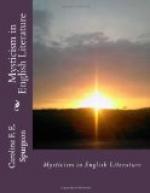And this process of intercourse between God and man is symbolised in the Incarnation, which is not a single event in time, but the culmination of an eternal process. It is the central fact of a man’s experience, “for it is going on perceptibly in himself”; and in like manner “the Trinity becomes the only and self-evident explanation of mysteries which are daily wrought in his own complex nature."[20] In this way is it that to Patmore religion is not a question of blameless life or the holding of certain beliefs, but it is “an experimental science” to be lived and to be felt, and the clues to the experiments are to be found in natural human processes and experiences interpreted in the light of the great dogmas of the Christian faith.
For Keats, the avenue to truth and reality took the form of Beauty. The idea, underlying most deeply and consistently the whole of his poetry, is that of the unity of life; and closely allied with this is the belief in progress, through ever-changing, ever-ascending stages. Sleep and Poetry, Endymion, and Hyperion represent very well three stages in the poet’s thought and art. In Sleep and Poetry Keats depicts the growth even in an individual life, and describes the three stages of thought, or attitudes towards life, through which the poet must pass. They are not quite parallel to the three stages of the mystical ladder marked out by Wordsworth in the main body of his poetry, because they do not go quite so far, but they are almost exactly analogous to the three stages of mind he describes in Tintern Abbey. The first is mere animal pleasure and delight in living—
A pigeon tumbling in clear
summer air;
A laughing school-boy without
grief or care
Hiding the springy branches
of an elm.
Then follows simple unreflective enjoyment of Nature. The next stage is sympathy with human life, with human grief and joy, which brings a sense of the mystery of the world, a longing to pierce it and arrive at its meaning, symbolised in the figure of the charioteer.
Towards the end of Keats’s life this feeling was growing stronger; and it is much dwelt upon in the Revision of Hyperion. There he plainly states that the merely artistic life, the life of the dreamer, is selfish; and that the only way to gain real insight is through contact and sympathy with human suffering and sorrow; and in the lost Woodhouse transcript of the Revision, rediscovered in 1904, there are some lines in which this point is still further emphasised. The full realisation of this third stage was not granted to Keats during his short life; he had but gleams of it. The only passage where he describes the ecstasy of vision is in Endymion (bk. i., 1. 774 ff.), and this resembles in essentials all the other reports of this experience given by mystics. When the mind is ready, anything may lead us to it—music, imagination, love, friendship.




